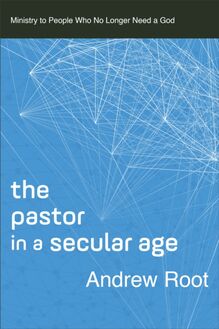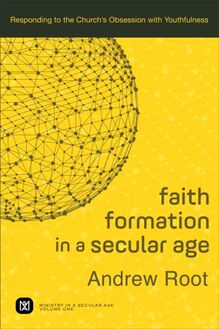Faith Formation in a Secular Age : Volume 1 (Ministry in a Secular Age) , livre ebook
158
pages
English
Ebooks
2017
Vous pourrez modifier la taille du texte de cet ouvrage
Obtenez un accès à la bibliothèque pour le consulter en ligne En savoir plus
Découvre YouScribe et accède à tout notre catalogue !
Découvre YouScribe et accède à tout notre catalogue !
158
pages
English
Ebooks
2017
Vous pourrez modifier la taille du texte de cet ouvrage
Obtenez un accès à la bibliothèque pour le consulter en ligne En savoir plus
Publié par
Date de parution
03 octobre 2017
Nombre de lectures
0
EAN13
9781493410316
Langue
English
Poids de l'ouvrage
3 Mo
Publié par
Date de parution
03 octobre 2017
EAN13
9781493410316
Langue
English
Poids de l'ouvrage
3 Mo
Cover
Title Page
Copyright Page
© 2017 by Andrew Root
Published by Baker Academic
a division of Baker Publishing Group
PO Box 6287, Grand Rapids, MI 49516-6287
www. bakeracademic.com
Ebook edition created 2017
All rights reserved. No part of this publication may be reproduced, stored in a retrieval system, or transmitted in any form or by any means—for example, electronic, photocopy, recording—without the prior written permission of the publisher. The only exception is brief quotations in printed reviews.
Library of Congress Cataloging-in-Publication Data is on file at the Library of Congress, Washington, DC.
ISBN 978-1-4934-1031-6
Unless otherwise indicated, Scripture quotations are from the Revised Standard Version of the Bible, copyright 1952 [2nd edition, 1971] by the Division of Christian Education of the National Council of the Churches of Christ in the United States of America. Used by permission. All rights reserved.
Scripture quotations labeled NRSV are from the New Revised Standard Version of the Bible, copyright © 1989, by the Division of Christian Education of the National Council of the Churches of Christ in the United States of America. Used by permission. All rights reserved.
Scripture quotations labeled NASB are from the New American Standard Bible®, copyright © 1960, 1962, 1963, 1968, 1971, 1972, 1973, 1975, 1977, 1995 by The Lockman Foundation. Used by permission.
Endorsements
“Andy Root expands youth ministry’s view and refocuses the conversation where it needs to be—on divine action, justification, faith, faith formation, and personhood. If you are a ministry leader, here is vision and language for youth ministry you must consider. If you are a seasoned youth worker with a sneaking suspicion that there’s more to your work, read this. If you are an aspiring youth worker, put this on your core reading list.”
— Steven Argue , Fuller Youth Institute, Fuller Theological Seminary
“Andy Root takes another ‘theological turn’ by identifying philosopher Charles Taylor as a yet unheard prophetic voice for the church. This book is sure to exercise our imaginations and reframe our perpetual quests for a ‘saving’ faith formation paradigm by advocating for our only hope—the divine encounter.”
— Sharon Galgay Ketcham , Gordon College
“Since Root first challenged the church to ‘revisit relational youth ministry,’ his works have led readers on a pilgrimage into an ever deeper understanding of incarnational ministry. This volume brings the rich fruits of that pilgrimage into sharp and accessible focus. Working from a deep engagement with Charles Taylor’s diagnosis of how the secular age has yielded notions of faith without encounter, transcendence, or transformation, Root offers the church a glittering vista of faith and ministry recentered on the transcendent encounter with Christ who comes to transform. If you are in seminary, you will want to add this to your canon of must-reads. If you are a youth worker, this volume offers you both fresh inspiration and a prescriptive way forward to a ministry that truly transforms.”
— Skip Masback , Yale Youth Ministry Institute, Yale Divinity School
“Andrew Root has become an iconic figure in youth ministry globally. In him, youth ministry has reached a pinnacle of scholarship, finding its sociocultural identity and theological hope. In this book, he leads readers into the thorny brambles of Charles Taylor’s ponderous philosophical account of secularity, through which youth ministry may be viewed as a fetishized site of authenticity, a front for the modern self—a construction of Deism and Freudian libidinal liberation. With a little help from Taylor’s notion of transcendence, Root offers a corrective to mere ‘authenticity’ in a kenotic theology that views Christian formation not as affiliation but as union ‘in Christ’ in ministry. More than any living writer, Root has sparked the theological imagination of a generation of youth ministers. In a field of practice notorious for ‘tips, tricks, and techniques’ this book promises not an easy way forward but one faithful nonetheless.”
— David F. White , Austin Presbyterian Theological Seminary
Dedication
To Kenda Creasy Dean
Your friendship, example, and witness have formed me as a scholar and a teacher.
To Richard Osmer (on your approaching retirement)
Your vision for formation stretches deep and wide.
Contents
Cover i
Title Page ii
Copyright Page iii
Endorsements iv
Dedication v
Preface ix
Introduction: Bonhoeffer Thinks We’re Drunk xv
Part 1: A History of the Age of Authenticity: The Challenge of Forming Faith 1
1. The Boring Church and the Pursuit of Authenticity 3
2. The History of Youthfulness 17
3. The Perceived Scam of the Mass Society 31
4. The Rise of the Hippie and the Obsession with Youthfulness 47
5. The Rise of Hip 63
6. Churches Filled with Bobos—the Beasts of Authenticity 73
Part 2: A Secular Age Meets Paul, and the Youthful Spirit Meets the Spirit of Ministry 95
7. Faith and Its Formation in a Secular Age 97
8. What Is Faith? 119
9. From Membership to Mystical Union 131
10. The Music of Formation 153
11. Is God a Favor Bestower or Gift Giver? 181
Conclusion: Practical Steps to Consider as the Household of Ministry 199
Index 213
Back Cover 219
Preface
The transition must have felt shockingly similar but so jarringly different. Imagine going to bed on October 4 and waking up on October 15. With just one eight-hour sleep you lost ten days. You can imagine workers, paid by the day, weren’t happy. This was money out of their pockets. And everyone was frightened. People wondered what it meant that ten days could have just disappeared . Days had been so dependable and now, in a flash, ten of them were gone. People couldn’t get their minds off the loss.
This isn’t a scene from a sci-fi movie; it actually happened in 1582. The genius mathematician Christopher Clavius discovered an error in the Julian calendar. This miscalculation put the calendar off by 0.002 percent per year. This doesn’t seem like much, but Clavius realized that it had amounted over the years to ten full days. These small, almost unseen changes had put things off by more than a week. So under the leadership of Pope Gregory XIII, a new calendar, bearing the pope’s name, was unveiled. People went to sleep on October 4 of the Julian calendar and woke up on October 15 of the Gregorian calendar. This was a huge change.
We live in the middle of our own transition as we experience the shifting of the framework in which the Western world has been built. Most of us don’t realize that we are living with a new calendar. Like people in the sixteenth century, we seem to be more concerned with what we’ve lost than with the fact that the whole calendar has shifted. This shift can be best summarized by a historical question posed by Charles Taylor, a question that peers back right to the time of Pope Gregory and the Protestant Reformation. Taylor asks, “Why was it virtually impossible not to believe in God in, say 1500, in our Western society, while in 2000 many of us find this not only easy, but even inescapable?” 1 Taylor’s question points to a huge, calendar-like transition in our world; we now live in a time when the experience of God is contested and to many (even those who still believe) doubtable.
And yet, like people in the sixteenth century, we seem to have our minds more on what has been lost than on this whole new calendar of our secular age. We are deeply concerned by the loss of church members, the loss of young people from youth groups, and the vitality of our institutions—big concerns, no doubt, but concerns that can’t really be addressed until we recognize that we are in a new time.
This project (and two volumes that will follow in the Ministry in a Secular Age series) will explore this new “calendar,” examining the impact of this secular age within which we now find ourselves. This first book will explore the core response to this perceived time of loss—the turn toward faith formation.
Faith formation has solid footing within the history of Christian thought and ministry. But over the last decade, this language of formation has become more and more important. Yet too often we’ve used it to respond to our perceived loss rather than to address the changes we face. Many popular faith-formation programs in the church, I believe, are stuck in this conception of loss, seeking to provide pragmatic actions to overturn decline and disaffiliation. We’ve turned to faith formation because of the rise of the “Nones” among young adults and the faith drifting of young people. Yet this focus on loss blinds us from fully seeing both what is at stake in the secular age we now live in and the need for new theological visions.
This book and the two that will follow it will take a similar pattern. They will start with an immersed discussion of elements of Charles Taylor’s argument in A Secular Age . I believe that Taylor’s book is one of the most important written so far in the twenty-first century. I often tell students and pastors that Taylor’s A Secular Age is the first philosophical book written in the twenty-first century that will be read in the twenty-second. Therefore, each of my books will provide a rich articulation of Taylor’s ideas in relation to a particular task of ministry. Yet it is important to avoid confusion here at the start. When Taylor says “secular,” he means not a world without religion but an age in which all belief systems are contestable and any claim of divine action is questioned. Taylor points us to the possibility that our issue isn’t necessarily people leaving the church but instead people no longer having ways to imagine the possibility of divine action or transcendence. Taylor’s presentation of our secular age is so nuanced and brilliant that each of my three books can only draw from parts of his argument. In this book, I look particularly at his description of the age of auth




